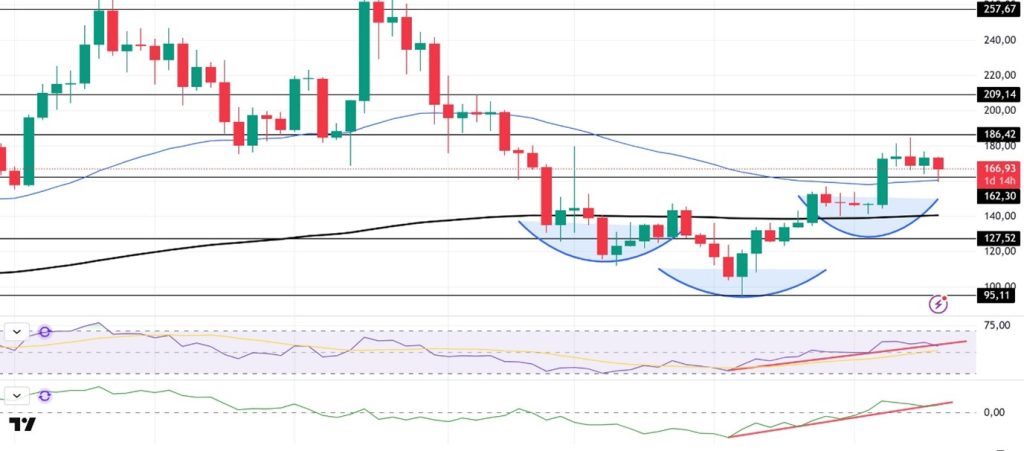Price Forecast and Overview
Solana (SOL) is one of the most exciting blockchain projects, but what does the forecast for the SOL price look like in the coming years? The Solana forecast is based on factors such as network utilization, technological progress and market developments. Some analysts expect prices to rise, while others warn of potential risks such as regulatory pressure or network disruptions. Solana price forecasts are based on factors such as network utilization, overall market sentiment and technological progress.
Price Forecast
Solana is known for its high volatility, reflected in strong price movements since the network launched in 2020. The cryptocurrency has experienced rapid price increases and sharp losses in a short period of time. During the crypto boom in 2021, the SOL price reached an all-time high of $260, only to fall below $10 by the end of 2022 during the subsequent market correction. Such fluctuations are typical for cryptocurrencies. But in Solana’s case, they are more affected by network events and market sentiment. In particular, repeated network outages in 2021 and 2022 caused uncertainty and strengthened criticism of the stability of the ecosystem. At the same time, past price action shows that Solana has often managed to rebound after periods of sharp losses. For example, SOL was at around $9.90 in January 2023 before appreciating throughout the year. This recovery was supported by increased interest in NFTs and DeFi applications on the Solana blockchain. In March 2024, the SOL price briefly reached the $200 level. In 2025, it reached a record high of $294.33 after US President Trump issued his own token on the Solana network.
Major Events 2025
- CME Group’s Solana Futures Contracts: CME Group announced plans to launch Solana futures contracts on March 17, 2025. This step has increased the likelihood of approval of exchange-traded funds (ETFs) based on Solana.
- Visa and Mastercard Integrations: Both payment giants have started using Solana for cross-border payments. In addition, financial institutions such as Franklin Templeton and BlackRock have launched asset tokenization projects on Solana.
- Stablecoin Expansions: The Trump-backed USD1 stablecoin and the integration of MakerDAO’s DAI into Solana provided liquidity to the DeFi ecosystem.
- Helium and Hivemapper: Helium’s decentralized 5G network and Hivemapper’s 140 million kilometers of mapping data across the globe have cemented Solana’s role in real-world applications.
- Render Network: Thanks to the Solana integration, Render Network has made significant advances in 3D graphics rendering.
- $TRUMP and PENGU: The $TRUMP memecoin, launched in January 2025, reached a market capitalization of $13 billion in two days. The PENGU token, airdropped in December 2024, reached a market capitalization of $2.5 billion.
- NFT Collectibles: Popular NFT collectibles like Pudgy Penguins and Azuki have revitalized the ecosystem by launching their own memecoins on Solana.
- ZenGo Wallet Integration: Solana integration with ZenGo’s multi-party computing (MPC) technology has enabled users to manage their assets more securely and easily.
- Hackathons and Events: Colosseum’s global hackathon attracted over 3,700 developers from more than 120 countries. In addition, events such as Solana Conf Accelerate and SolsticeConf in New York increased community engagement.
- Scheduled for release in mid-2025, the Seeker phone will be available in 57 countries at a price of $500. The device will be integrated with Solana staking and DeFi apps.
Price and ROI Performance in the Past 5 Years
| Year | Opening Price ($) | Closing Price ($) | Annual ROI (%) |
|---|---|---|---|
| 2020 | 0.22 | 1.53 | 595% |
| 2021 | 1.53 | 170.31 | 11,178% |
| 2022 | 170.31 | 9.96 | -94.4% |
| 2023 | 9.97 | 101.44 | 917% |
| 2024 | 101.44 | 189.68 | 73.3% |
Technical Outlook
The Sol price has fallen by approximately 20% since the beginning of the year. After failing to break the strong resistance at 257.67, the asset fell by about 65%, hitting its lowest point this year at $96.24 on April 7, from where it rose by about 81% to trade at $166.68. On the other hand, the shoulder-head-shoulder pattern should be taken into account. On the 3-day chart, the 50 EMA (Blue Line) continued to be above the 200 EMA (Black Line). This signals that the uptrend may continue in the medium term. CMF (20) (Chaikin Money Flow) is in positive territory. At the same time, positive inflows this year may continue to push CMF up. In addition, it continues to be above the uptrend that started on April 4. But it is currently testing this as support. If it breaks here, it may fall down to the 200 EMA. When we look at the RSI (14) (Relative strength index), it continues to be in the positive zone, but we can say that the buying pressure has decreased while continuing to hold above the uptrend that started on April 4. The $257.67 level stands out as a strong resistance point in the event of an uptrend on the back of macroeconomic data or positive news on the Solana ecosystem. If this level is broken upwards, the rise can be expected to continue. If there are pullbacks due to contrary developments or profit realizations, the $ 127.52 level may be retested. In case of a decline to these support levels, the increase in buying momentum may offer a potential bullish opportunity.
Supports 162.30 – 127.52 – 95.11
Resistances 186.42 – 209.14 – 257.67
Expected Developments in Solana
Solana plans to double the block space by 2025 and significantly increase the already high transaction volume.
A new consensus algorithm is being implemented that will eliminate voting and increase certainty and block times.
Firedancer, a new authenticator client, is expected to go live in 2025, potentially improving network performance and reliability.
Secret transfers have recently been implemented in Solana, increasing the secrecy of the transaction.
Helix is working on RPS 2.0, which aims to separate the read layer from the write layer in Solana’s architecture.
Institutional interest in Solana has shifted from “should we invest?” to “how can we use Solana?”.
The Solana Policy Institute was established to engage with policymakers and shape the regulatory debate.
Solana’s proposal to increase capacity from 48 to 60 million computing units (CUs) is currently on the test network.
Accelerate, defined as a “mini-breaking point” event, will be held in the United States between May 19-26, 2025.
Solana is often discussed with Ethereum in institutional conversations about leading blockchain platforms.
The Solana ecosystem is witnessing a rapid pace of development and innovation.
Solana has set “IBRL” (In-Block Reactive Latency) as a North Star target for the development of the network.
The podcast hosts suggest that 2025 could be the biggest year yet for technological developments in the Solana network.
2025 Year-End Expectations
Bull Scenario:
We expect a positive outlook for Solana’s price forecast, pointing to technological advancements, increased adoption and institutional interest. Solana’s high transaction speed and low fees can be cited as competitive advantages. Moreover, NFTs and DeFi projects on the Solana blockchain continue to gain importance.
Based on all of this, and assuming that the ecosystem continues to evolve and market demand increases, we can predict that Solana’s price could break the $390 mark by the end of 2025. This prediction is based on the growing use of Solana for transactions in the DeFi sector and the support of large companies. According to asset manager VanEck, the price of Solana could reach $520 by the end of 2025, which would represent an increase of 207% from its current value. The basis for this forecast is a growing smart contract market, where Solana’s share could increase from 15% to 22%. The main driver for this is high developer activity combined with increasing DeFi and DEX trading volumes. The growing popularity of Solana-based memecoins is also contributing to adoption. Higher institutional demand could further support Solana: VanEck and financial firm Grayscale have filed for an ETF with the US Securities and Exchange Commission (SEC), which could further entrench Solana in the traditional financial sector.
Bear Scenario:
Macroeconomic uncertainties, competition from Ethereum and Layer 2 solutions, and technical issues are growth barriers for Solana. Network outages, as in the past, can erode user trust in the long run.
A major outage in February 2023 was caused by a faulty software update and resulted in a 20-hour network paralysis. In other cases, the causes were initially unclear and required extensive analysis by developers to restore stability. These recurring disruptions raise concerns about Solana’s long-term reliability. Users and investors may turn away due to network instability, limiting Solana’s growth potential. If regulatory uncertainty increases or the network continues to experience technical problems, the SOL price could fall below $50 by the end of 2025. Market experts highlight potential capital outflows from risky crypto assets if US interest rates remain high and global financial conditions worsen. The reported 39% drop in DApp usage could signal further downside potential.
Analyst Estimate:
Solana offers a scalable blockchain known for low transaction costs and high transaction speed. These advantages point to a positive long-term outlook, especially in sectors such as NFTs and DeFi. Institutional interest is another important indicator. Major companies such as Visa have announced their support for Solana for payments using USDC stablecoins. However, Solana remains exposed to market cycles. In the past, its price has increased or decreased by more than 50% in a few months. Forecasts for the average price in 2025 vary widely depending on the scenario. In the crypto ecosystem, Solana is seen as one of the leading smart contract platforms with Ethereum and Binance Smart Chain. It has gained a strong position in the NFT sector with projects such as Magic Eden competing with OpenSea. Future predictions for Solana largely depend on how well its blockchain performs against its competitors. While Ethereum remains the standard for DeFi projects, Solana’s faster transactions and lower fees support its growing adoption. Whether Solana can continue to grow in the ecosystem will depend on improvements in network security, scalability and developer activity. We can say that Solana’s potential price range in 2025 will be between $200 and $400. The forecast assumes that Solana will continue to grow but will be subject to fluctuations without forming a clear trend. The positive aspects are Solana’s high transaction speed and low fees, which continue to support strong utilization in the DeFi and NFT sectors. In addition, institutional interest and technological advancement hold promise for long-term growth.
Conclusion
Forecasts for the cryptocurrency Solana are subject to uncertainty due to the many factors that influence its price. Solana is a highly volatile cryptocurrency and is often affected by regulatory changes, technological developments and macroeconomic conditions. A key risk is network outages, which can undermine trust in the Solana ecosystem. For example, an outage in May 2022 rendered Solana unavailable for several hours, causing investors to worry. In addition, competition from Ethereum and Layer 2 solutions remains a risk to Solana’s future outlook. If Ethereum solves its scalability issues, Solana could lose market share. Regulatory uncertainties, such as stricter rules for DeFi projects, could also have long-term implications.
Solana’s price remains difficult to predict as many factors shape price trends. Some analysts and market experts predict a strong increase, while others warn of potential downturns. Tools like on-chain analysis, fundamental analysis and technical trading indicators can help traders make informed decisions. Anyone investing in Solana should pay attention to forecasts, follow developments regularly and avoid relying solely on price predictions. It is worth bearing in mind that past performance is not a reliable indicator of future results.
Disclaimer
This content has been prepared by the Darkex Research Team for informational purposes only. It does not constitute investment advice. All risks and responsibilities arising from your investment decisions are solely your own.





